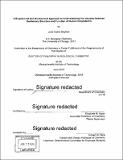A biophysical and biochemical approach to understanding the interplay between Quaternary structure and function of human calprotectin
Author(s)
Stephan, Jules Rabie
DownloadFull printable version (32.35Mb)
Other Contributors
Massachusetts Institute of Technology. Department of Chemistry.
Advisor
Elizabeth M. Nolan.
Terms of use
Metadata
Show full item recordAbstract
In response to an invading pathogen, the host organism initiates an immune response to fight infection. One component of the response involves metal-sequestering proteins that starve pathogens of essential metal nutrients. Humans release calprotectin (CP), a heterooligomer of S100A8 and S100A9, from neutrophils and epithelial cells to prevent microbes from accessing manganese, iron, nickel, and zinc. CP also binds Ca(II) ions, which increases the transition-metal affinity and antimicrobial activity of CP. In addition, Ca(II) causes the S100A8/S100A9 CP heterodimer to form a S100A82/S100A9₂ tetramer. When this dissertation research began, it was known that CP inhibited bacterial growth by sequestering transition metals, and that CP could transmit a proinflammatory signal; however, little was known about the fate of CP after release. The focus of this work was to better understand how the extracellular space may affect CP on biophysical and biochemical levels. Our approach was to study the molecular-level consequences of Ca(II) binding and tetramerization. We found that the heterotetramer exhibited significant resistance to enzymatic proteolysis compared to the heterodimer. Using NMR spectroscopy, we observed that the dynamics of CP change significantly upon Ca(II) binding small, yet notable, alterations in secondary structure. Finally, we discovered that methionine oxidation of CP inhibited Ca(II)-induced tetramerization, resulting in accelerated proteolysis. Taken together, our studies provided new insights into how CP survives the harsh conditions of the extracellular space, and a mechanism for clearing CP from the extracellular space.
Description
Thesis: Ph. D. in Biological Chemistry, Massachusetts Institute of Technology, Department of Chemistry, 2018. Cataloged from PDF version of thesis. Vita. Includes bibliographical references.
Date issued
2018Department
Massachusetts Institute of Technology. Department of ChemistryPublisher
Massachusetts Institute of Technology
Keywords
Chemistry.